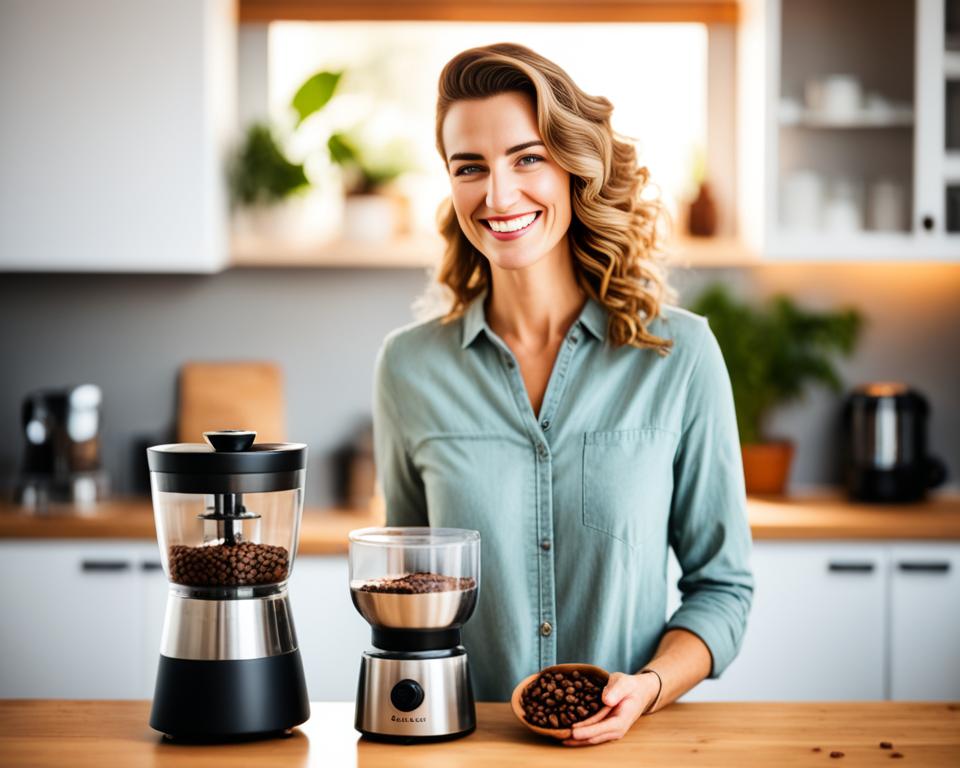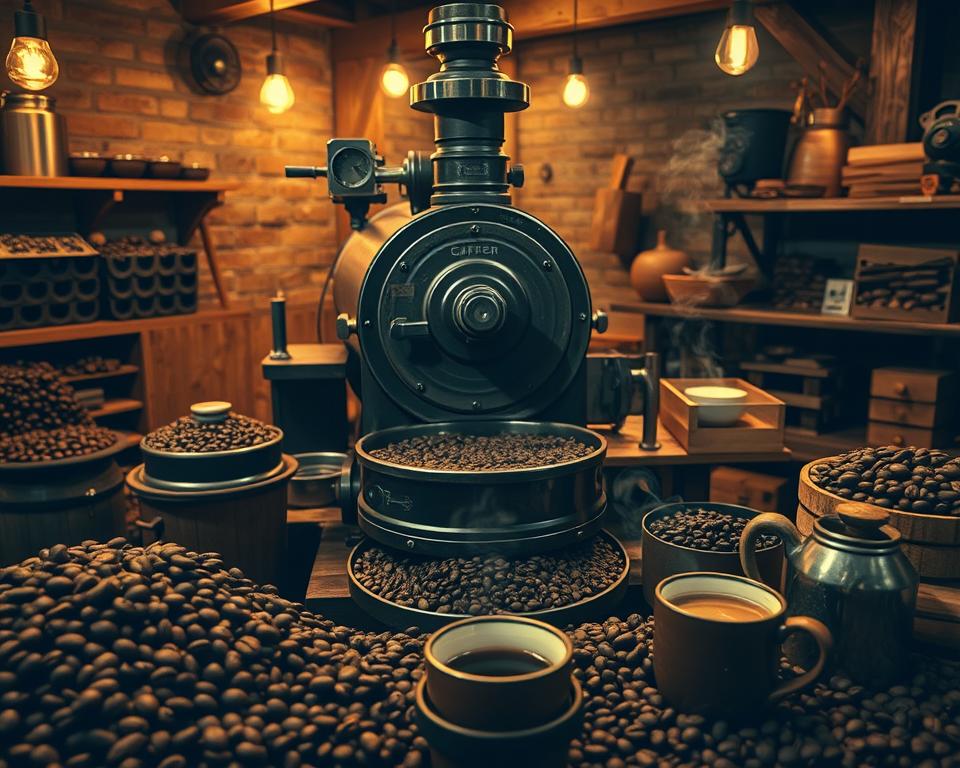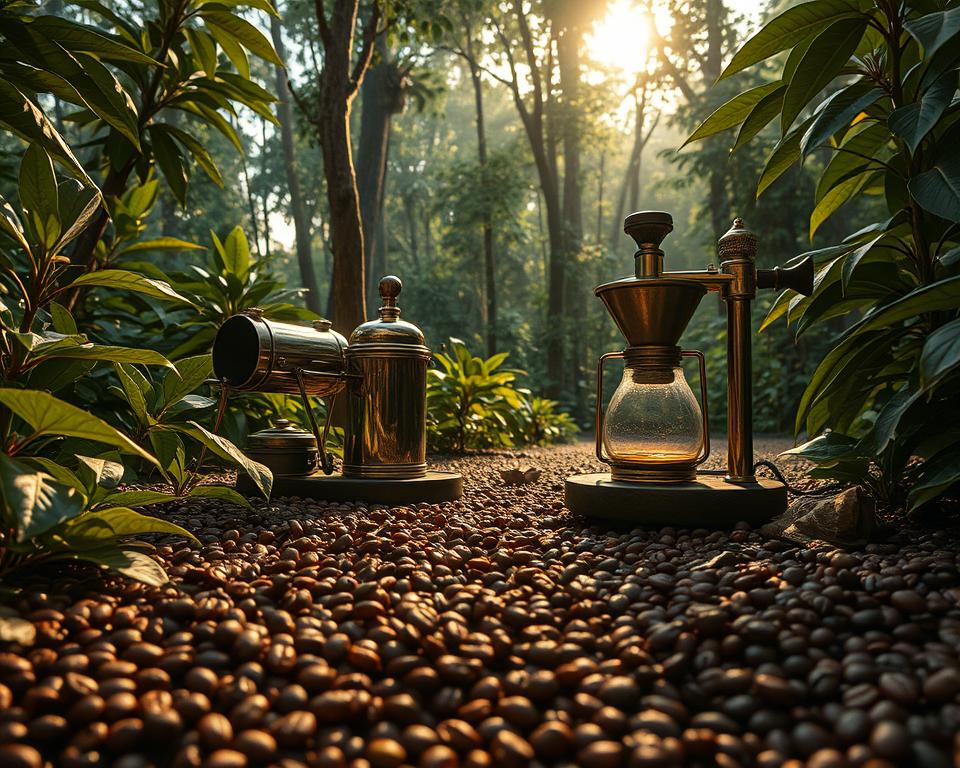Did you know that home coffee roasting can save you up to 50% compared to buying pre-roasted beans from specialty stores? It’s true! Home coffee roasting isn’t just about cost savings, though. It’s about taking control of the flavour and freshness of your morning cup and transforming raw green beans into aromatic delights.
If you’re a coffee lover, roasting your own beans at home can be a game-changer.
I remember my first time roasting coffee at home. The rich, full aroma filled my kitchen, and I was hooked. Imagine having that experience and crafting a brew that’s perfectly tailored to your taste. Intrigued yet?
In this guide, I’ll walk you through everything you need to know about DIY coffee beans. You’ll learn the benefits of home coffee roasting, how to control the roast level, and all the steps to get started.
Ready to discover how to roast coffee at home and elevate your coffee experience? Let’s get started on this flavorful journey!
Understanding the Basics of Home Roasting
Home roasting offers several exciting benefits that make it irresistible for any coffee lover. By diving into coffee roasting basics, you can enjoy fresher and more flavorful coffee and the satisfaction of creating a personalised roast.
Why roast your own coffee?
Why should you consider roasting your coffee? Think about the cost savings and the incredible benefits of home roasting. Not only do you get a fresher cup, but you also obtain the joy of crafting a flavour profile that suits your taste.
Imagine sipping on coffee you’ve roasted and customised yourself. It’s an amazing experience.
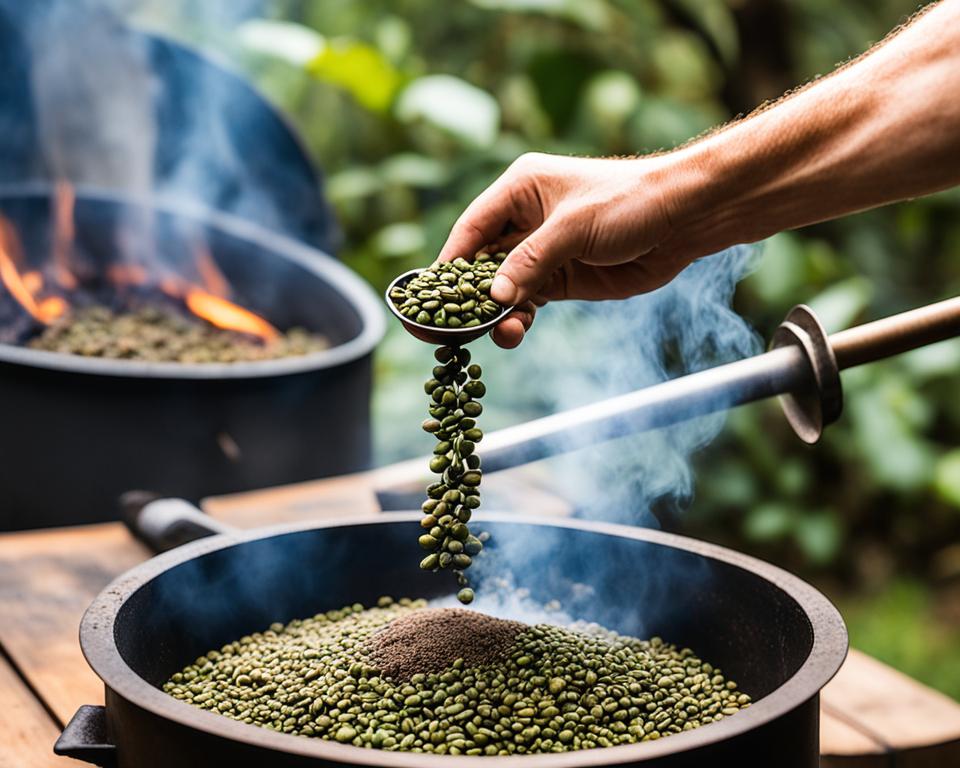
The Science Behind Coffee Roasting
The transformation of green coffee beans is a fascinating process. Let’s dive into the science! Coffee roasting involves complex chemical changes such as the Maillard reaction and caramelization.
These reactions are central to developing the flavors and aromas in your coffee. Understanding these elements is key to mastering the basics of coffee roasting.
Varieties of Coffee Beans
Another crucial aspect of the basics of coffee roasting is knowing your bean varieties. Coffee bean types significantly affect the final taste. From Arabica to Robusta, each type invites distinctive flavors and roasting requirements.
Learning about different coffee bean types will help you make informed choices and elevate your home roasting journey.
Essential Equipment for Home Roasting
Roasting coffee at home can bring a whole new level of freshness and control to your coffee experience.
To get started, you’ll need some specific home roasting equipment to ensure everything goes smoothly.
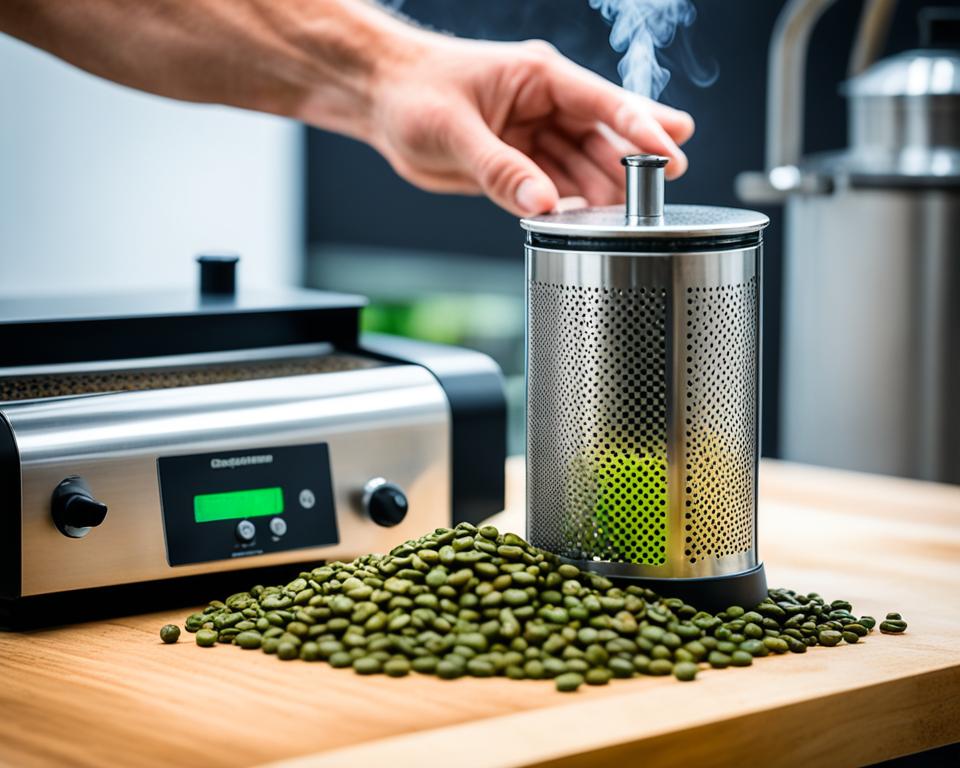
Home Roasting Machines
There are different types of home roasting machines, each offering unique features. You can start simple with a stovetop popcorn popper, which is a popular choice among beginners.
However, if you’re serious about home roasting, a dedicated coffee roaster like the Behmor 2000AB or FreshRoast SR540 can offer more precise control over the roasting process.
Other tools you might need
Beyond the main coffee roaster, there are several roasting tools that can enhance your home roasting. Accurate scales are crucial for weighing green beans before and after roasting. A good thermometer helps you monitor the temperature to achieve the desired roast level.
Additionally, having proper storage containers will help keep your freshly roasted beans at their best.
These home roasting equipment and tools will set you up for success and help you perfect your own coffee roasting technique. Happy roasting!
How to Prepare Your Coffee Beans
Before you start roasting, preparing coffee beans correctly is key. This initial step can significantly affect the flavour and quality of your final roast.
The first thing I usually do is sort through the raw coffee beans, removing any defective ones or debris. It’s a small effort that makes a big difference!
Once sorted, I move on to washing the beans. Some folks skip this, but I find washing helps remove any remaining dust or residue. After washing, it’s crucial to dry the beans thoroughly.
I spread them out on a clean towel and let them air dry. This ensures they’re ready for the roast prep stage.
One aspect that’s often overlooked is the importance of batch size. Whether you’re working with a small or large batch, consistency in the size will help in achieving an even roast. Keep in mind that different roast levels may require different batch sizes.
The storage of your green beans also plays a role in how well they roast. I like to store my unroasted beans in a cool, dry place, away from direct sunlight.
Proper raw coffee bean prep involves understanding these details to unlock the best flavours during roasting.
- Sort the beans.
- Wash and dry them.
- Consider batch size.
- Store green beans properly.
By following these steps, you’ll ensure that your raw coffee bean prep sets the stage for a successful roasting experience. Happy roasting!
Step-by-Step Guide on How to Make Your Own Coffee Beans
Roasting your own beans at home is an exciting journey. Let’s walk through the essentials to get you started on your very own DIY coffee bean roasting adventure.
Selecting Your Coffee Beans
The foundation of a great roast starts with choosing the right beans. Opt for high-quality green beans from regions known for their coffee excellence, such as Ethiopia or Colombia.
Pay attention to bean origins, processing methods, and flavour profiles to match your personal taste. Whether you’re into fruity notes or a nutty finish, there’s a perfect bean out there for you.
Roasting Techniques
Once you’ve selected your beans, it’s time to dive into roasting. There are various methods to consider, including using a dedicated coffee roaster, a popcorn popper, or even a stovetop pan.
Each technique offers its own unique experience and flavour outcome. For beginners, I recommend starting with a simple stovetop method or an oven to get a feel for the process.
Remember, monitoring the colour and smelling the aroma during roasting are crucial steps to ensure you achieve the desired roast level, be it light, medium, or dark.
Cooling and Storing Your Beans
After you achieve the perfect roast, cooling the beans quickly is essential to stop the roasting process. Spread them out on a baking sheet to cool evenly.
Proper storage is key to preserving freshness. Use airtight containers and store them in a cool, dark place to maintain their flavor. Avoid freezing or refrigerating, as this can lead to moisture buildup.
Enjoy the fruits of your labour by brewing a fresh cup of coffee with your beautifully roasted beans!
Different Roasting Methods You Can Try
Exploring various coffee bean roasting methods can be both exciting and rewarding. Each method brings its own unique advantages and flavours, so let’s dive in!
Oven Roasting
Oven coffee roasting is one of the simplest methods to begin with. It involves spreading the beans on a baking sheet and placing them in a preheated oven.
While this method may lack precise temperature control, it’s an accessible starting point for beginners. Keep an eye on the beans, stirring occasionally to ensure even roasting.
Stovetop Roasting
This method utilises a simple pan or a stovetop popcorn popper. Stovetop bean roasting requires constant stirring to prevent burning and achieve an even roast.
A key benefit is the hands-on control over the roasting process, but be prepared for smoke and ventilation needs.
Popcorn Popper Method
Using a popcorn popper for coffee roasting is a popular choice due to its efficiency and ease of use. Air popcorn poppers work best, as they provide the consistent airflow needed for proper roasting.
Just remember to leave the lid ajar slightly to allow chaff to escape, and be ready for some trial and error to find your preferred roast profile.
Troubleshooting common roasting issues
Even the most experienced home roasters encounter coffee roasting problems from time to time. Let’s explore some typical issues and offer practical tips for fixing roast issues easily.
Dealing with Over-Roasting
Over-roasting is when your beans turn too dark or even burn. This issue can cause a bitter taste in your coffee. To avoid this, always keep an eye on your beans during the roast.
Aim for a medium roast on your initial attempts, and gradually experiment with darker roasts. It’s helpful to use a timer and monitor the temperature closely. If you notice a burnt smell, it’s time to stop.
Under-Roasting Issues
Under-roasting occurs when beans are not roasted enough, resulting in a grassy or sour flavor. To fix under-roasting issues, ensure the beans crack at least once.
The first crack is a sign that the beans are reaching the desired roast level. Increasing the roasting time slightly can help achieve a fuller flavour.
Inconsistent Roasting Problems
Inconsistent roasting can lead to beans with varied roast levels, affecting the overall flavor. To minimize this, stir or shake the beans regularly during roasting to ensure even heat distribution.
Use an evenly heated roasting method, like an air roaster, which helps maintain a consistent temperature throughout.
By being mindful of these common coffee roasting problems, you’ll become more proficient in home roasting. Remember, practice makes perfect, and soon you’ll master the art of fixing roast issues, leading to a more satisfying coffee experience.
Storing Your Freshly Roasted Coffee Beans
Properly storing coffee beans is essential to preserving their freshness and flavor. By following effective storage practices, you can greatly enhance your coffee experience.
Optimal Storage Conditions
To ensure the best coffee preservation, store your beans in a dark, cool, and dry place. Avoid exposing them to direct sunlight or moisture. Using airtight containers is key to preventing oxidation, which can negatively impact flavour.
Glass jars with airtight seals or specialised vacuum-sealed containers work wonders. Room temperature is ideal, so steer clear of refrigerating or freezing unless absolutely necessary, as these environments can introduce moisture.
Long-term storage tips
For long-term coffee storage solutions, consider portioning your beans into smaller batches. This reduces frequent exposure to air. My favourite method involves using one-way valve bags designed specifically for coffee beans, as they allow gases to escape while preventing air from getting in.
Remember, grinding your beans right before brewing is another crucial step in coffee preservation. By following these tips, you’ll enjoy a rich and flavorful cup from the first sip to the last.
How Does Your Home Roasting Technique Compare to Expert Tips for Making Coffee Beans?
To truly elevate your coffee experience, it’s essential to master the art of coffee roasting. By comparing your home roasting technique to expert tips, you can refine your process. Pay attention to factors like temperature, timing, and bean origins to unlock deeper flavors and the perfect brew in every cup.
Conclusion
Roasting coffee at home is more than just a fun hobby; it’s a journey that lets you unlock the full potential of your beans. I’ve guided you through understanding the basics, gathering the right equipment, and mastering various roasting methods.
Each step is a building block that brings you closer to enjoying the rich and flavorful coffee you’ve always desired.
One of the greatest home-roasted coffee benefits is the control you get over the flavor profile of your cup. You can experiment with different beans and roasting levels to craft a brew that’s uniquely yours.
The joy of sipping a morning coffee, knowing you handled every part of its creation, is truly unparalleled.
So, why not start your home roasting journey today? The satisfaction of brewing with your own beans is unmatched, and the process itself is deeply rewarding.
Share your roasted coffee with friends and family, bask in the compliments, and enjoy home roasting as a new and enriching part of your coffee experience. Let’s get those beans roasting and embark on this delightful adventure together!
FAQ
What is home coffee roasting?
Home coffee roasting is the process of roasting green, raw coffee beans at home to create fresh and flavorful coffee. By roasting your own beans, you have control over the roast level, allowing you to customise the flavour according to your preference.
Why should I roast my own coffee?
Roasting your own coffee at home can save money, provide a fresher taste, and give you the satisfaction of creating your own unique roast. Additionally, you can experiment with different roast levels and bean varieties to find the perfect cup for your taste.
What equipment do I need to start home coffee roasting?
You’ll need some essential equipment, such as a home roasting machine or a suitable alternative like a pan, stovetop, or popcorn popper. Other helpful tools include scales, thermometers, and airtight containers for storing your freshly roasted beans.
What types of coffee beans can I use for home roasting?
You can use a wide variety of coffee beans for home roasting. Common types include Arabica, Robusta, Liberica, and Excelsa. Each type of bean offers different flavour profiles and characteristics, so you can experiment to find which one you like best.
How do I prepare my coffee beans for roasting?
Begin by sorting, washing, and drying your green coffee beans. Proper preparation is essential for achieving a consistent roast. Also, ensure you’re aware of the ideal batch size and how to store your green beans before roasting.
What are the different roasting techniques I can try at home?
There are several roasting techniques you can try, including light, medium, and dark roasts. Each technique will impact the flavour, aroma, and overall profile of the coffee. You can experiment with different methods to find the one that suits your taste.
How can I avoid common issues like over-roasting or under-roasting?
One way to avoid over-roasting or under-roasting is to closely monitor the colour, smell, and sound of the beans during the roast. Understanding the signs of each roasting stage will help you achieve the desired roast level and avoid common pitfalls.
What is the best way to store freshly roasted coffee beans?
To maintain the freshness and flavour of your roasted beans, store them in an airtight container in a cool, dark place. For long-term storage, consider using vacuum-sealed containers or freezer-safe bags to prevent exposure to air and moisture.

